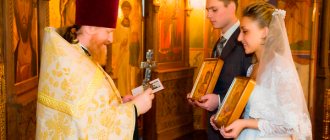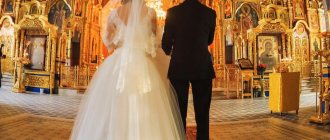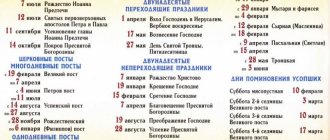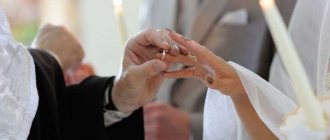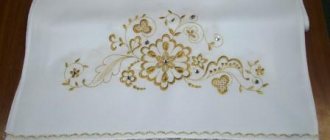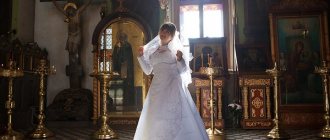How does the sacrament of wedding take place?
How much does a church wedding cost?
The total wedding budget consists of the prices of what needs to be purchased for the wedding (list below) and donations to the church or priest; there is no single price list for such services. Everything needs to be discussed in the church where you are getting married.
You need to buy for the ceremony: (Temple workers will offer to buy everything for the wedding from them)
- Wedding icons. Image of the Mother of God and Christ.
- Wedding Candles (pair)
- Wedding towel (towel) You will stand on it
- Wedding napkins for candles. The wax will flow and getting on your hands is not very pleasant.
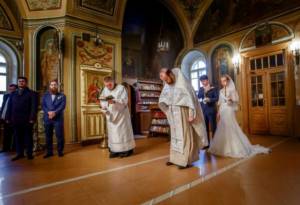
For the wedding ceremony you must have with you:
- Marriage certificate
- Passports
- Rings
- Pectoral crosses, that is, you must be baptized.
Decide about witnesses in advance!!! These should be people close to you and hardy. Preferably taller than your height. They will have to hold the wedding crowns over your heads for 30-40 minutes. Nowadays, however, more and more often, crowns are put directly on the head (train your neck - they are heavy). And witnesses (boyfriends, best men) are also not required now.
How does the Sacrament of Wedding take place in church?
The ceremony consists of four stages:
- Engagement
- Wedding
- Resolution of the Crowns
- Thanksgiving prayer
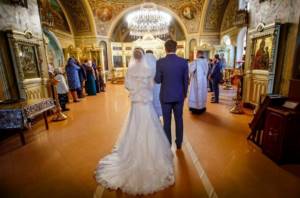
Engagement
By tradition, the bride and groom must arrive at the church separately, in the modern world, when a wedding before official registration in the registry office is almost impossible, it looks a little strange, but such are the traditions. First the groom enters the church, then the bride. The appearance of the young people at the temple means that the husband receives a wife from the Lord Jesus Christ. The priest who conducts the ceremony comes out through the royal gates in full vestments. He has a cross and a Gospel in his hands.
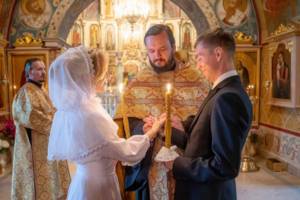
He leads the newlyweds inside the temple to commemorate the fact that those getting married begin from this moment their new and holy life in a pure marriage. The priest blesses the groom three times, and then the bride with two lit candles, after which he passes the candles to the wedding party. A burning candle is a symbol of chastity and purity. The priest reads aloud a prayer that the Lord bless the young people for every good deed. Wedding rings are placed on the throne, on the right side, as if in front of the face of the Lord Jesus Christ himself, in order to receive a blessing for eternal love and illuminate the beginning of a new generation. The priest puts the ring on the groom first, then the bride. Do not be alarmed and do not try to tell the priest that he has mixed up the rings, the exchange of rings just begins.
After the blessing of the priest, the bride and groom exchange rings three times (usually with the help of a priest), as a sign of mutual agreement, unanimity and understanding in marriage.
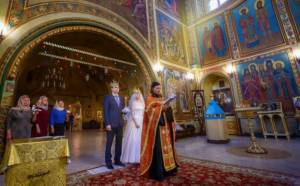
Wedding
To the beginning Wedding The newlyweds join their right hands so that the groom's hand lies on the bride's hand. The priest covers his hands with the stole and leads them across the rivers to the center of the temple hall with the words of the psalm. The bride and groom stand on a towel.
The priest, standing in front of the lectern on which the cross and the Gospel lie, asks the young people to confirm in the face of God and each other, as well as everyone present, their voluntary and spontaneous desire to get married and the absence of any obstacles to this.
The marriage is considered concluded, and the priest performs the sacrament of consecrating the marriage - the wedding. Then comes the most important moment of the wedding. With a crown in the shape of a crown, he makes the sign of the cross over the groom. After this, the crown is placed on the groom's head. In the same way, the priest blesses the bride, adorned with crowns, the bride and groom stand before the face of God himself and await God's blessing.
The sacred moment of the wedding has arrived. A cup of red wine is brought. The priest gives wine to the young people to drink from a common cup three times. From now on, they should have everything in common - happiness, joy, and sorrow. The priest again joins the right hands of the young people, covers them with the stole and places his hand on top of it.
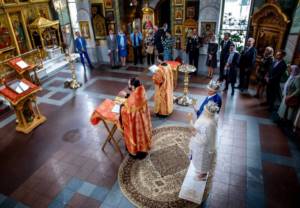
Thus, through the hand of the priest, the husband receives a wife from the church itself, uniting them in Christ forever.
Resolution of the Crowns
At the end of the sacred rite of marriage, they read a prayer for the permission of the crowns, so that the Lord, who gave the newlyweds crowns as a reward for chastity and chastity before marriage, would himself bless the permission of their crowns and keep the marriage indissoluble. The priest makes the sign of the cross over the newlyweds and, taking the candles from them, congratulates them on the joy of blessing their marriage.
Thanksgiving prayer.
The priest serves a prayer service of thanksgiving to the Lord God in front of the royal doors, after which he performs dismissal, naming the names of the saints who patronize the young.
When they definitely don't hold a wedding.
- On Tuesdays, Thursdays and Saturdays;
- during the Great, Petrov, Assumption, and Nativity fasts;
- on the eve of the twelve, temple and great holidays;
- in continuation of Christmastide, from January 7 to 20;
- during Cheese Week (Maslenitsa);
- during Easter (Light) Week;
- on the days (and on the eve) of the Beheading of John the Baptist, and the Exaltation of the Cross of the Lord.
Traditionally, the best time for a wedding is considered to be autumn, winter days from Epiphany to Maslenitsa, in the summer, between Petrov and Assumption fasts, and on Krasnaya Gorka (the first Sunday after Easter).
Is it possible to get married while pregnant?
There are no restrictions on this; there are priests who look askance at this. Therefore, it is important to clarify this with the priest. But in my practice, filming weddings for pregnant women, even in later stages, is not at all uncommon.
Where to get married? In which church to get married in Moscow?
I photographed weddings in many Moscow churches, and if necessary I can suggest something. From a photographer’s point of view, it is important that the temple is beautiful and not very crowded. But if you are already a parishioner of any church, then what is the point of changing anything and looking for another one.
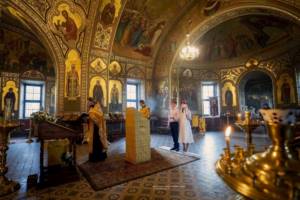
Here the decision is yours. I had to film in churches at hospitals (which are never closed for the sacrament) and in the Yelokhovskaya church, where the tourist trail leads. Everywhere you can make the ceremony look beautiful and majestic. If you have questions about choosing a temple, write to me. I will be happy to share a list of temples and contacts
Makeup for a wedding
The Church has never approved any kind of makeup, but a modern woman wants to be beautiful, so makeup for a wedding should be almost invisible. Light, delicate, transparent, no aggressive or bright colors. No glitter. The wedding hairstyle is also a little different from the usual wedding hairstyle. If you need a makeup artist for your wedding, I will be happy to advise you.
Filming the wedding ceremony
Rustam Khadzhibaev is a photographer who photographs everything that concerns the relationship between two people who love each other: weddings, honeymoon trips and love stories.
As a wedding photographer, I often receive orders to photograph weddings, which have become especially popular lately. I’ll say right away that I really love filming in churches. Temples have always been designed and built taking into account natural light. And although the amount of light in temples sometimes leaves much to be desired, its quality almost always inspires me very much. Windows at different levels and along the perimeter of the temples provide wonderful natural volumetric light. The street light pouring into the windows, the warm light of burning church candles, as well as the smoke from them and the priest’s censer dissolved in the air, emphasizing the tonal perspective - all this creates a magical, mysterious and very attractive atmosphere in churches of any religion.

Aperture – f/3.2 Shutter speed – 1/160, ISO 2500 Focal length – 32 mm Camera – Nikon D750 Lens – AF-S NIKKOR 24-70mm f/2.8G ED
And if there are windows on the dome, then at certain times you can happily observe amazing pillars of light there. The sun hits the inside of the temple at any time of the day, and watching this movement of light is a lot of fun! On a sunny day at any hour, the light picture is full of magic and enchantment. If the day is cloudy, cloudy, it will not be possible to get light pillars, but the lighting will still be very interesting, since in such conditions the light from internal lamps or chandeliers begins to work, which, illuminating the slightly smoky atmosphere of the temple, creates a completely cinematic effect.

Aperture – f/5 Shutter speed – 1/100, ISO 2000 Focal length – 14 mm Camera – Nikon D800 Lens – AF-S NIKKOR 14-24mm f/2.8G ED
Since I work mostly in Moscow, naturally, I most often shoot in Orthodox churches. The high height of their arches makes it possible to shoot effectively from the top and bottom points. Nothing will stop you from shooting from the floor level, from the lowest point, but getting to the upper tier, if there is one, can sometimes be difficult. Here, communication skills and the ability to gain the trust of clergy will help you. And if you drive up to the temple a couple of days before the wedding and take some beautiful pictures outside and inside, and before the wedding present the printed photographs to the priests, then you will not have problems with permission, which means your photo session will be enriched with a wonderful view from above.

Aperture – f/2.8 Shutter speed – 1/125, ISO 2000 Focal length – 14 mm Camera – Nikon D3S Lens – AF-S NIKKOR 14-24mm f/2.8G ED
Clergy usually treat photographers favorably if you approach them before the wedding and politely ask for a blessing to take pictures. Respect for internal church rules and the priest’s advice about places where it is acceptable to be and where it is not desirable is the key to successful work.
For example, it is strictly forbidden to cross the space between the newlyweds and the priest. If we talk about the dress code, we must not forget that wearing shorts and short skirts is prohibited in the temple. Female photographers must have a scarf or headscarf, since women in the temple must have their heads covered. You should also keep in mind that the wedding process is long and you won’t be able to leave, so it’s better to have a good snack and go to the toilet in advance.
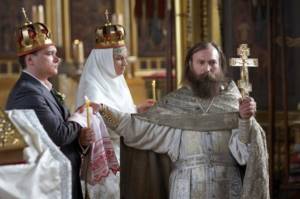
Aperture – f/1.6 Shutter speed – 1/125, ISO 2000 Focal length – 35 mm Camera – Nikon D3S Lens – AF-S NIKKOR 35mm f/1.4G

Aperture – f/2.2 Shutter speed – 1/250, ISO 1000 Focal length – 85 mm Camera – Nikon D750 Lens – AF-S NIKKOR 85mm f/1.4G

Aperture – f/2.8 Shutter speed – 1/125, ISO 2000 Focal length – 14 mm Camera – Nikon D3S Lens – AF-S NIKKOR 14-24mm f/2.8G ED
If we talk about technology, then, firstly, we must forget about the flash. She is in the temple - absolute evil. Not only does it interfere with the correct perception of the sacrament of the wedding, but it also destroys that very wonderful play of light. Doing this on purpose, in my opinion, is the ultimate photographic sin. And when I sometimes see photographers in the temple with endlessly flashing and clicking cameras, my indignation knows no bounds. Modern cameras provide excellent quality at high sensitivity and, coupled with fast lenses, allow you to shoot in almost darkness, solving the problems of shooting in very difficult light conditions.
And if we talk about the noise level, in the temple I prefer to shoot with a Nikon D750 camera with a very quiet shutter, as well as a completely silent Nikon 1 j5 mirrorless camera. A second camera is a must, as there simply won’t be time to change lenses at the climax. And, in any case, there should be a backup camera to insure against unforeseen situations.
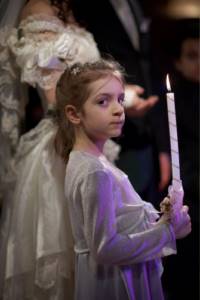
Aperture – f/1.8 Shutter speed – 1/250, ISO 1600 Focal length – 85 mm Camera – Nikon D700 Lens – AF-S NIKKOR 85mm f/1.4G
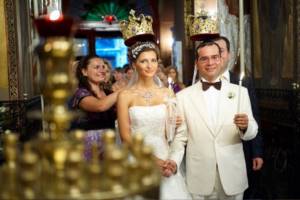
Aperture – f/2 Shutter speed – 1/200, ISO 1600 Focal length – 85 mm Camera – Nikon D700 Lens – AF-S NIKKOR 85mm f/1.4G
I have several popular lenses for weddings: AF-S NIKKOR 14-24mm f/2.8G ED - it is indispensable for shooting interior spaces, it gives a majestic, three-dimensional picture. AF-S NIKKOR 24mm f/1.4G ED, AF-S NIKKOR 35mm f/1.4G – these lenses are good for shooting long shots of groups of people or newlyweds in full height. AF-S NIKKOR 85mm f/1.4G – for large and half-length portraits.
I photographed weddings several times in the Pokrovsky Old Believer Cathedral on Rogozhsky Lane. The rules of the Old Believers are much stricter, so I had to show remarkable calm, fighting off the old women who, even despite the priest’s permission, still tried to forbid me to film in their temple. But the light there was so amazing that I simply didn’t pay attention to them.
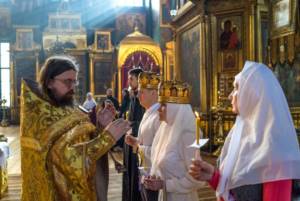
Aperture – f/3.2 Shutter speed – 1/500, ISO 2500 Focal length – 40 mm Camera – Nikon D750 Lens – AF-S NIKKOR 24-70mm f/2.8G ED

Aperture – f/3.2 Shutter speed – 1/500, ISO 2500 Focal length – 35 mm Camera – Nikon D750 Lens – AF-S NIKKOR 24-70mm f/2.8G ED
We also had to film in the churches of the Armenian Apostolic Church. The wedding process itself is very solemn and intimate there.
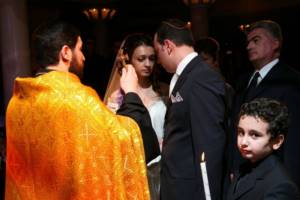
Aperture – f/1.8 Shutter speed – 1/160, ISO 3200 Focal length – 35 mm Camera – Nikon D3S Lens – AF-S NIKKOR 35mm f/1.4G

Aperture – f/1.8 Shutter speed – 1/250, ISO 1600 Focal length – 85 mm Camera – Nikon D700 Lens – AF-S NIKKOR 85mm f/1.4G
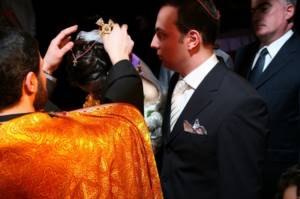
Aperture – f/1.4 Shutter speed – 1/125, ISO 4000 Focal length – 35 mm Camera – Nikon D3S Lens – AF-S NIKKOR 35mm f/1.4G

Aperture – f/1.8 Shutter speed – 1/250, ISO 1600 Focal length – 85 mm Camera – Nikon D700 Lens – AF-S NIKKOR 85mm f/1.4G
Once, while filming a wedding in a small chapel near the Moscow Ring Road, where there was literally nowhere for an apple to fall and there was no way to even raise the camera, I had to lie on the floor at the feet of the priest and film from below in order to film everything that was happening in the magnificent light penetrating into the chapel from the window in the top of the wall. The AF-S NIKKOR 14-24 f2.8/G ED lens was very helpful here. We must pay tribute to the priest: he didn’t even turn an eye in my direction.
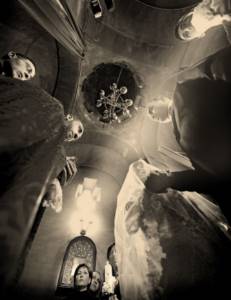
Aperture – f/2.8 Shutter speed – 1/80, ISO 400 Focal length – 14 mm Camera – Nikon D700 Lens – AF-S NIKKOR 14-24mm f/2.8G ED

Aperture – f/2.8 Shutter speed – 1/125, ISO 2000 Focal length – 14 mm Camera – Nikon D3S Lens – AF-S NIKKOR 14-24mm f/2.8G ED
There are many interesting details during a wedding that are worth paying attention to: hands holding burning candles, drinking church wine from beautiful cups, details of the priest’s vestments, a holy book on which an interesting light falls. Here it is important to continuously observe and record everything visually interesting. Then, when viewing the photo shoot, these photos will serve as a kind of interruptions, which will improve the overall impression of the shoot.
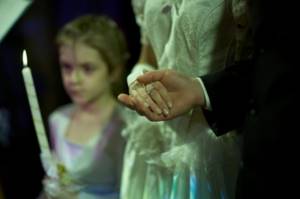
Aperture – f/1.8 Shutter speed – 1/250, ISO 1600 Focal length – 85 mm Camera – Nikon D700 Lens – AF-S NIKKOR 85mm f/1.4G
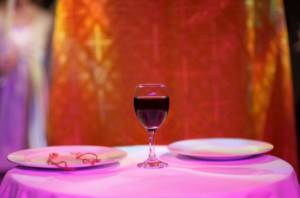
Aperture – f/1.8 Shutter speed – 1/250, ISO 1600 Focal length – 85 mm Camera – Nikon D700 Lens – AF-S NIKKOR 85mm f/1.4G
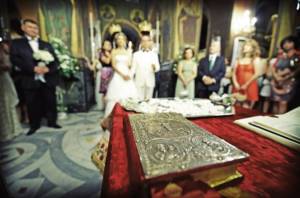
Aperture – f/2.8 Shutter speed – 1/125, ISO 2000 Focal length – 14 mm Camera – Nikon D3S Lens – AF-S NIKKOR 14-24mm f/2.8G ED
I really love watching the behavior of guests who, in the temple, having abandoned the bustle of the street, become themselves, peacefully observing what is happening or immersing themselves in themselves.
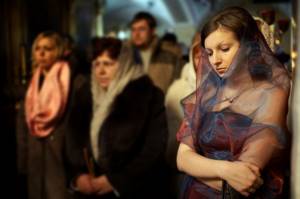
Aperture – f/1.6 Shutter speed – 1/160, ISO 2000 Focal length – 35 mm Camera – Nikon D3S Lens – AF-S NIKKOR 35mm f/1.4G
And of course, the final part of the wedding with congratulations and the ceremonial exit of the couple from the temple is very important, where the photographer needs to have reporter skills in order not to miss a single important moment.
Before going out, warn the newlyweds about the emotions that it is advisable to see in this situation. After an exciting and tiring wedding procedure, their emotional state requires a shake-up, and here everything depends on the photographer’s ability to find encouraging words.
It is also important to prepare everyone present, usually parents and relatives. Take them to the exit and place them beautifully on the steps of the entrance to the temple. Then take the advantageous shooting point and sign to invite the newlyweds to the exit. The result will please both you and your customers.
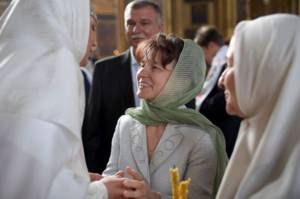
Aperture – f/2.2 Shutter speed – 1/250, ISO 2000 Focal length – 35 mm Camera – Nikon D3S Lens – AF-S NIKKOR 35mm f/1.4G

Aperture – f/3.5 Shutter speed – 1/250, ISO 1250 Focal length – 48 mm Camera – Nikon D750 Lens – AF-S NIKKOR 24-70mm f/2.8G ED
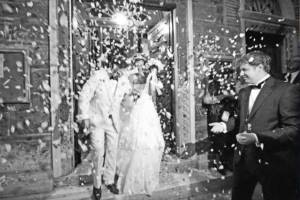
Aperture – f/3.2
Shutter speed – 1/125, ISO 2000 Focal length – 15 mm Camera – Nikon D3S Lens – AF-S NIKKOR 14-24mm f/2.8GE
Filming the wedding ceremony
Wedding and wedding on the same day or on different days? Which is better?
My opinion is better to do it on different days. Both registration and wedding are 2 very big emotional events. And if you add a photo shoot and a banquet to this, then, most likely, your strength will leave you in the middle of the day. But you should still rejoice at the banquet.
It is better to hold the wedding and the Sacrament of Marriage on different days.
And finally, a few tips
1. You hired a professional photographer for the wedding, ask guests and relatives not to use video cameras and cameras in the Temple, frequent flashes of point-and-shoot cameras will distract the priest and disturb you.
2. Do not look on the Internet for information on how to behave during a Wedding; it is better to ask the priest performing the Wedding.
3. During the wedding, do not look into the lenses. You didn’t come to church to take pictures, but to get married. It's the photographer's job to photograph you. If time and the abbot then allow, it will be possible to take several staged photos in the Temple.
4. Try to hold the candles so that the flame is no higher than shoulder level, try to keep the candles level. Be careful with the veil.
Features of photographing in a church
To take photographs in the church during the ceremony, you must obtain permission from the priest. Please note that it is prohibited to enter some parts of the temple. For a professional photographer, it is also advisable to clarify the possibility of using a flash. You can ask the priest for his blessing to take pictures - then there will be more successful pictures. An experienced photographer knows the order of the sacrament of baptism and chooses the right angles, without missing the main moments, because the priest will not pose during the ceremony and wait until he gets a good shot. He will conduct high-level reporting without interfering with the process of the child’s baptism and without attracting the attention of others.
It’s good if the sacrament takes place individually, then the photographer will have the opportunity to catch even minor nuances and take photographs from a convenient angle. There will be no strangers in the finished photographs - only family and friends invited to the sacrament. Usually the ceremony does not take much time, but is accompanied by the crying of the child and the worries of the parents, and at an individual baptism there will be no extra eyes or distracting noise.
Since temples are usually built to the east, the best time for the baptism ceremony is from 11 a.m. to 3 p.m. After the sun sets to the west, the natural lighting of the temple deteriorates, and the use of a flash in the temple is undesirable - it distorts the beauty of the golden decoration and disturbs the priest, guests and the baby.
The photographer must have time to photograph the key moment of baptism - dipping the baby into the font. This needs to be reflected in high quality photographs, it is best to take a series of quick shots to get the best selection. If the sacrament is performed in a special room - the baptistery (baptismal room or annex), then it is more advisable to use a flash. Flash photography is generally prohibited inside the temple itself.
The sacrament of a wedding is distinguished by its duration and greater monotony. The photographer must be familiar with the church ceremony, since during the ceremony he should behave quietly and inconspicuously, but at the same time have time to shoot important moments.
